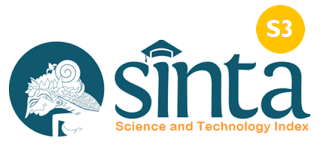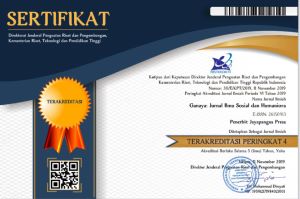Collaborative Governance Dalam Pengelolaan Hutan Mangrove
(Studi Kasus Suku Akit Desa Hutan Panjang Kecamatan Rupat Kabupaten Bengkalis)
DOI:
https://doi.org/10.37329/ganaya.v8i4.4946Keywords:
Collaborative Governance, Mangrove Forest, Akit Indigenous, Local WisdomAbstract
This study discusses the implementation of collaborative governance in mangrove forest management in Hutan Panjang Village, Rupat District, Bengkalis Regency. The Akit Indigenous People are positioned as key actors alongside the Village Government and the Forest Management Unit (KPH). The Akit community possesses local wisdom in preserving mangrove forests through traditional practices such as replanting mangrove trees after harvesting. This wisdom reflects a balance between economic utilization and environmental conservation. However, the sustainability of mangrove forests faces several challenges, including environmental degradation, climate change, and government policies that often conflict with customary norms and indigenous land rights. The purpose of this research is to analyze conservation practices, patterns of collaboration among actors, and forms of community adaptation to policy changes and environmental conditions. The study employs a descriptive qualitative approach with data collected through in-depth interviews, focus group discussions (FGDs), and documentation. Informants were selected purposively, consisting of village officials, KPH representatives, and members of the Akit Indigenous People, totaling 15 participants. The findings reveal a trust gap between the community and the government due to formal regulations such as the 2018 Regional Regulation perceived as misaligned with customary practices and local livelihoods. Consequently, community participation in government programs remains low because of concerns about restricted access to natural resources. In the collaboration process, the Village Government acts as a facilitator, the KPH functions as a technical manager through rehabilitation and training programs, while the Akit community maintains ecosystem sustainability through local wisdom. This study concludes that the sustainability of mangrove management depends on the alignment of government policies with local wisdom, strengthened communication among actors, and the provision of alternative livelihoods based on community participation. The study contributes to the development of collaborative governance theory and natural resource management grounded in the local knowledge of coastal indigenous communities.
References
Ansell, C., & Gash, A. (2007). Collaborative Governance in Theory and Practice. Journal of Public Administration Research and Theory, 18(4), 543–571.
Arrozaaq, D. L. C. (2016). Collaborative Governance (Studi tentang Kolaborasi Antar Stakeholders dalam Pengembangan Kawasan Minapolitan di Kabupaten Sidoarjo). Kebijakan dan Manajemen Publik, 3(1), 1–13.
Aslika, N., Siti, R., & Sidiq, S. (2024). Suku Akit dalam Pemanfaatan Hutan Mangrove Sungai Liong Desa Berancah Kecamatan Bantan Kabupaten Bengkalis. Jurnal Sosial dan Humaniora, 2(1), 238–242.
Bennett, J. W. (2017). The Ecological Transition: Cultural Anthropology And Human Adaptation. Routledge.
Edo Herlangga, R., & Basuni, S. (2019). Stakeholder Management of Kawasan Konservasi Mangrove dan Bekantan in Tarakan City. Jurnal Manajemen Hutan Tropika, 23(5), 146–153.
Emerson, K., Nabatchi, T., & Balogh, S. (2012). An Integrative Framework for Collaborative Governance. Journal of Public Administration Research and Theory, 22(1), 1–29.
Hermanto, W., Sujianto, & As’ari, H. (2023). Strategi Pengelolaan Hutan Mangrove di Kecamatan Bantan Kabupaten Bengkalis. Jurnal Ilmu Pemerintahan, 4(2), 317–328.
Juhri Agus Tan, T., & Hakim Siregar, L. (2021). Peranan Ekosistem Hutan Mangrove pada Mitigasi Bencana bagi Masyarakat Pesisir Pantai. Jurnal Teknologi Reduksi, 1(1), 27–35.
Kalsum, U., Hadi Purwanto, R., Rahayu Wijayanti Faidah, L., & Sumardi. (2022). The Role of Stakeholders in the Management of the East Luwuk Mangrove Forest, Banggai Regency, Central Sulawesi Province. Jurnal Hutan Pulau-Pulau Kecil, 6(1), 83–93.
O’Connell, D. P., Fusi, M., Djamaluddin, R., Rajagukguk, B. B., Bachmid, F., Kitson, J. J. N., Dunnett, Z., Trianto, A., Tjoa, A. B., Diele, K., & Evans, D. M. (2022). Assessing Mangrove Restoration Practices Using Species-Interaction Networks. Restoration Ecology, 30(4), 1–13.
Reza Herdasuri, & Syafhendri. (2015). Evaluasi Kebijakan Pemerintah tentang Perlindungan Hutan di Kabupaten Bengkalis. Journal UIR, 53(9).
Rijali, A. (2018). Analisis Data Kualitatif. Jurnal UIN Antasari Banjarmasin, 17(33), 81–95.
Saam, Z. (2018). Kehidupan Masyarakat Adat Suku Akit dan Kearifan Lokal Bahtera Alam. Bahtera Alam. https://bahteraalam.org/2021/01/15/kehidupan-masyarakat-adat-suku-akit-dan-kearifan-lokal-tulisan-1/
Stewart, T., & Ruckdeschel, C. (1998). Intellectual Capital: The New Wealth of Organizations. Performance Improvement, 37(7), 56–59.
Sufia, R., Sumarmi, & Amirudin, A. (2016). Kearifan Lokal dalam Melestarikan Lingkungan Hidup: Studi Kasus Masyarakat Adat Desa Kemiren Kecamatan Glagah Kabupaten Banyuwangi. Jurnal Pendidikan: Teori, Penelitian, dan Pengembangan, 1(4), 726–731.
Wicaksono, F. (2021). Collaborative Governance dalam Pengembangan Pusat Pemberdayaan Ekonomi dan Kreativitas Masyarakat di Kota Bandung. Decision: Jurnal Administrasi Publik, 2(2).
Yuliana, D., Kinseng, R. A., Dharmawan, A. H., & Soetarto, E. (2022). Actor’s Social Actions and Their Dynamics in the Social System: A Case Study of Traditional Charcoal-Making Business in the Livelihood of the Akit Community. Sodality: Jurnal Sosiologi Pedesaan, 10(2), 196–208.
Downloads
Published
How to Cite
Issue
Section
License
Copyright (c) 2025 Hadi Candra, Rina Mardiana, Nurmala K. Pandjaitan (Author)

This work is licensed under a Creative Commons Attribution-ShareAlike 4.0 International License.
An author who publishes in the Ganaya : Jurnal Ilmu Sosial dan Humaniora agrees to the following terms:
- Author retains the copyright and grants the journal the right of first publication of the work simultaneously licensed under the Creative Commons Attribution-ShareAlike 4.0 License that allows others to share the work with an acknowledgement of the work's authorship and initial publication in this journal
- Author is able to enter into separate, additional contractual arrangements for the non-exclusive distribution of the journal's published version of the work (e.g., post it to an institutional repository or publish it in a book) with the acknowledgement of its initial publication in this journal.
- Author is permitted and encouraged to post his/her work online (e.g., in institutional repositories or on their website) prior to and during the submission process, as it can lead to productive exchanges, as well as earlier and greater citation of the published work (See The Effect of Open Access).
Read more about the Creative Commons Attribution-ShareAlike 4.0 Licence here: https://creativecommons.org/licenses/by-sa/4.0/.








